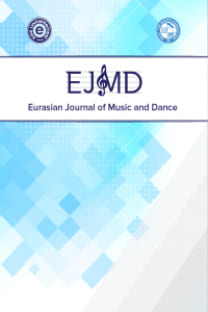Türk Uluslararası Sanat Müziği Bestecilerinin Eserlerinde Türk Müziğinin Geleneksel Türleri ve Biçimleri
19. yüzyıl, müzikte ulusalcı hareketlerin görüldüğü dönemdi. Ulusalcılık
Anahtar Kelimeler:
Geleneksel Türk müziği biçimleri, geleneksel Türk müziği türleri, geleneksel Türk müziği, Türk Beşleri, Türkiye’nin uluslararası sanat müziği bestecileri
TRADITIONAL FORMS AND GENRES OF TURKISH MUSIC IN THE CREATIONS OF INTERNATIONAL ART MUSIC COMPOSERS OF TURKEY
19th century was an era of nationalist movements in music. Nationalism wasseen in important regions of the world, especially in Russia and NorthernEurope. These nationalistic movements affected international art musiccomposers of Turkey in the early years of Turkish Republic. GenerallyTurkish composers preferred to use traditional folk music elements instead ofthe elements of traditional art music. Either folk music with its melodiccharacteristic or maqam structure of art music is used by many internationalTurkish composers after the Turkish Fives. Generally, maqam factors areused as building stones in the compositions. The genre has been the lessmentioned subject than maqam regarding the reflection of tradition. Besides,it is seen that the forms and genres of folk music are used in international artmusic. Here I present the composers’ preferences regarding Turkish musicgenres with notation samples.
Keywords:
Turkish traditional forms, Turkish traditional genres, Turkish international art music composers, Turkish traditional music, Turkish fives,
___
- Akdoğu, Onur (1996). Türk Müziğinde Türler ve Biçimler. İzmir: Ege Üniversitesi Basımevi.
- Altınköprü, Halil (2004). “Cumhuriyet Döneminde Türk Müziğinde Çağdaşlaşma Çalışmaları ve Hasan Ferid Alnar”. Unpublished master's thesis. İzmir: Ege Üniversitesi.
- “Atabarı (Bahçası Var Bağı Var)”. http://www.turkudostlari.net/nota.asp?turku=114. Retrieved in June 1, 2017.
- Aydın, Yılmaz (2003). Türk Beşleri. Ankara: Müzik Ansiklopedisi Yayınları Şen Matbaası.
- “Bir Sevdâ Geldi Başıma - Köçekçe Notası.” https://www.turksanatmuzigi.org/notalarimiz/hicaznotalari/ bir-sevda-geldi-basima-kocekce-notasi. Retrieved in June 1, 2017.
- “Bozlak”. https://www.turkudostlari.net/ezgi.asp?nota=784 Retrieved June 20, 2018.
- “Burçak Tarlası (Sabahınan Kalktım) (Halay)”. http://www.baglamist.com/b/burcak-tarlasi-sabahinan-kalktim-halay.html. Retrieved in June 1, 2017.
- “Ferahnak”. http://www.muziklopedi.org/files/nota/nota_1236806329.pdf. Retrieved in June 25, 2017.
- “Nihavend Oyun Havası”. http://projetsm.com/uploads/attachment/20631_v1_1.gif. Retrieved June 25, 2017.
- “Oynayın Gız Oynayın (Kız Atlatma Horonu)”. http://www.turkuler.com/nota/ezgi_oynayin_kiz_oynayin.html. Retrieved in June 1, 2017.
- Özkan, İsmail Hakkı (2003), Türk Musıkîsi Nazariyatı ve Usûlleri Kudüm Velveleleri. İstanbul: Ötüken Neşriyat A.Ş.
- Saygun, Ahmed Adnan (1955). Sivas Düz Halayı Üç Türkülük Süit Op. 23, No 4 Bariton ve Piyano İçin. Ankara: Devlet Konservatuvarı Yayınları.
- Sözer, Vural (2005). Müzik Ansiklopedik Sözlük. İstanbul: Remzi Kitabevi A.Ş.
- Şenel, Onur (2006). “Ferit Tüzün’ün Çağdaş Türk Besteciliği İçin Önemi”. Unpublished master's thesis. Ankara: Başkent Üniversitesi.
- “Uzun Hava”. https://www.turkudostlari.net/ezgi.asp?nota=386. Retrieved in June 1, 2017
- “Yağcılar Zeybeği”. http://www.turkuler.com/nota/ezgi_yagcilar_zeybegi.html Retrieved June 1, 2017.
- Yalçın, Gökhan ve Özer Kutluk (2012). “Muammer Sun’un Yurt Renkleri 1. Albümde Yer Alan Piyano Eserlerinin Armonik Analizi,” JASSS The Journal of Academic Social Science Studies, 5(7):769-788.
- ISSN: 2651-4818
- Yayın Aralığı: Yılda 2 Sayı
- Başlangıç: 2011
- Yayıncı: Ege Üniversitesi
Sayıdaki Diğer Makaleler
SESTEN NOTAYA: SÛZİNÂK İLÂHÎ, “AŞKIN İLE ÂŞIKLAR” ÖRNEĞİ
VİDEO OYUN MÜZİKLERİNİN ÜNİVERSİTE ÖĞRENCİLERİNİN DAVRANIŞLARINA ETKİSİNİN İNCELENMESİ
Uğur BAKAN, Mücahit Yalçin ÖZTÜFEKÇİ
RAKSTAN OYUNA Türkiye’de Dansın Modern Halleri
GİRESUN HALK OYUNLARI -Etnokoreolojik Bir Değerlendirme
9/8 ROMAN DANSI Kültür, Kimlik, Dönüşüm ve Yeniden İnşa
GELENEKSEL TÜRK SANAT MÜZİĞİNDE MAKAM GEÇKİLERİ
İZMİR’DEKİ TÜRK SANAT MÜZİĞİ AMATÖR KOROLARININ İNSAN YAŞAMINDAKİ YERİ
TÜRKİYE’DE MODERNLEŞME SÜRECİNİN MÜZİĞE YANSIMALARI BAĞLAMINDA “KLASİK KORO” ÖRNEĞİ
